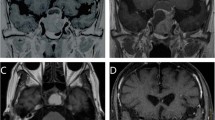Abstract
Stereotactic radiosurgery (SRS) is frequently used for Cushing’s disease (CD) after failed pituitary surgery. Management of patients with persistent CD after failed SRS is complex, as the alternative therapeutic options harbor significant risks. The outcomes of repeat pituitary radiosurgery, however, have not been described. We sought to determine the outcomes of repeat SRS in patients with CD. We pooled data from five institutions participating in the International Gamma Knife Research Foundation for patients with recurrent or persistent CD ≥ 12 months after initial SRS. Patients were included in the study if they had ≥ 6 months endocrine follow-up after repeat SRS. Twenty patients were included in the study. Repeat single-session SRS was performed 1.3–9.7 years after initial SRS. Median endocrine follow-up was 6.6 years (1.4–19.1 years). Median margin dose was 20 Gy (range 10.8–35 Gy). Endocrine remission after second SRS was noted in 12 patients (60%), with a median time to remission of 6 months (range 2–64 months). Biochemical recurrence occurred in two patients (17%) after initial remission. Overall, the cumulative rates of durable endocrine remission at 5 and 10 years were 47 and 53%, respectively. Two patients (10%) experienced adverse radiation effects, including transient visual loss and permanent diplopia. Repeat SRS achieves lasting biochemical remission in approximately half of patients with CD refractory to both prior microsurgery and SRS. Because of the morbidity of refractory or recurrent CD, repeat SRS should be considered for carefully selected patients with hypercortisolism confirmed one or more years after initial SRS.


Similar content being viewed by others
References
Clayton RN, Raskauskiene D, Reulen RC, Jones PW (2011) Mortality and morbidity in Cushing’s disease over 50 years in Stoke-on-Trent, UK: audit and meta-analysis of literature. J Clin Endocrinol Metab 96:632–642
Lonser RR, Wind JJ, Nieman LK et al (2013) Outcome of surgical treatment of 200 children with Cushing’s disease. J Clin Endocrinol Metab 98:892–901
Hofmann BM, Hlavac M, Martinez R et al (2008) Long-term results after microsurgery for Cushing disease: experience with 426 primary operations over 35 years. J Neurosurg 108:9–18
Semple PL, Vance ML, Findling J, Laws ER (2000) Transsphenoidal surgery for Cushing’s disease: outcome in patients with a normal magnetic resonance imaging scan. Neurosurgery 46:553-8-9
Ciric I, Zhao JC, Du H et al (2012) Transsphenoidal surgery for cushing disease: experience with 136 patients. Neurosurgery 70:70–80
Nieman LK, Biller BMK, Findling JW et al (2015) Treatment of Cushing’s syndrome: an endocrine society clinical practice guideline. J Clin Endocrinol Metab 100:2807–2831
Mehta GU, Lonser RR (2017) Management of hormone-secreting pituitary adenomas. Neuro Oncol 19:762–773
Nagesser SK, van Seters AP, Kievit J et al (2000) Long-term results of total adrenalectomy for Cushing’s disease. World J Surg 24:108–113
Assie G, Bahurel H, Coste J et al (2006) Corticotroph tumor progression after adrenalectomy in Cushing’s disease: a reappraisal of nelson’s syndrome. J Clin Endocrinol Metab 92:172–179
Estrada J, Boronat M, Mielgo M et al (1997) The long-term outcome of pituitary irradiation after unsuccessful transsphenoidal surgery in Cushing’s disease. N Engl J Med 336:172–177
Mehta GU, Ding D, Patibandla MR et al (2017) Stereotactic radiosurgery for Cushing disease: results of an international, multicenter study. J Clin Endocrinol Metab 102:4284–4291. https://doi.org/10.1210/jc.2017-01385
Marks LB, Yorke ED, Jackson A et al (2010) Use of normal tissue complication probability models in the clinic. Int J Radiat Oncol Biol Phys 76:S10-9
Snell JW, Sheehan J, Stroila M, Steiner L (2006) Assessment of imaging studies used with radiosurgery: a volumetric algorithm and an estimation of its error. J Neurosurg 104:157–162
Peduzzi P, Concato J, Feinstein AR, Holford TR (1995) Importance of events per independent variable in proportional hazards regression analysis II. Accuracy and precision of regression estimates. J Clin Epidemiol 48:1503–1510
Lonser RR, Nieman L, Oldfield EH (2017) Cushing’s disease: pathobiology, diagnosis, and management. J Neurosurg 126:404–417
Ram Z, Nieman LK, Cutler GB et al (1994) Early repeat surgery for persistent Cushing’s disease. J Neurosurg 80:37–45
Castinetti F, Guignat L, Giraud P et al (2014) Ketoconazole in cushing’s disease: is it worth a try. J Clin Endocrinol Metab 99:1623–1630
Daniel E, Aylwin S, Mustafa O et al (2015) Effectiveness of metyrapone in treating Cushing’s syndrome: a retrospective multicenter study in 195 patients. J Clin Endocrinol Metab 100:4146–4154
Colao A, Petersenn S, Newell-Price J et al (2012) A 12-month phase 3 study of pasireotide in Cushing’s disease. N Engl J Med 366:914–924
Cifarelli CP, Schlesinger DJ, Sheehan JP (2012) Cranial nerve dysfunction following Gamma Knife surgery for pituitary adenomas: long-term incidence and risk factors. J Neurosurg 116:1304–1310
Lee C-C, Vance ML, Xu Z et al (2014) Stereotactic radiosurgery for acromegaly. J Clin Endocrinol Metab 99:1273–1281
Lee CC, Chen CJ, Yen CP et al (2014) Whole-sellar stereotactic radiosurgery for functioning pituitary adenomas. Neurosurgery 75:227–237
Acknowledgements
We appreciate the assistance of Ms. Linda Baxendell with coordination of data for the International Gamma Knife Research Consortium.
Author information
Authors and Affiliations
Corresponding author
Ethics declarations
Conflict of interest
Dr. Lunsford reports stock ownership in Elekta AB.
Rights and permissions
About this article
Cite this article
Mehta, G.U., Ding, D., Gupta, A. et al. Repeat stereotactic radiosurgery for Cushing’s disease: outcomes of an international, multicenter study. J Neurooncol 138, 519–525 (2018). https://doi.org/10.1007/s11060-018-2817-5
Received:
Accepted:
Published:
Issue Date:
DOI: https://doi.org/10.1007/s11060-018-2817-5




